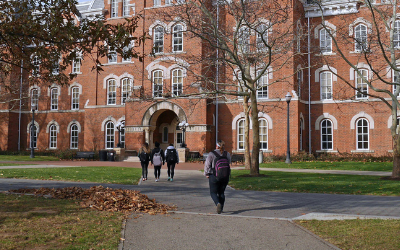Here are 2 campus safety measures colleges are buying into

This article was originally posted on University Business
A 2023 report by Campus Safety found that more than seven out of 10 (71%) campus protection professionals in higher ed, K12 and hospitals say they either plan on deploying new or upgraded mass notification solutions in the next two years, a 20-point increase compared to 2017.
With classes now well underway this fall for the majority of institutions, colleges and universities are looking to optimize their students’ success, especially among first-year students. But institutions are also looking to optimize campus safety amid a wave of stark reminders about how necessary it is.
Last week, Howard University suspended its campus police lieutenant and fired a security officer after a mob of 20 to 50 teenagers kicked, punched and stabbed a group of university students near a residence hall. Last fall semester, an expelled University of Arizona student shot and killed a professor on campus after searching an academic hall for multiple faculty members whom he had also threatened previously.
Incidents such as these have helped bring a revamped focus from campus police and related stakeholders to strengthen student safety measures, many of which are bolstered by emerging technologies.
“Safety is number one for us, for everybody on this campus—whether you’re a student staff, visitor, parent or somebody just wandering around campus for the first time,” said Chou Her, Assistant Vice Chancellor for Public Safety and Police Chief at University of California, Merced, according to ABC 30.
Campus notification systems skyrocket in popularity
A 2023 report by Campus Safety found that more than seven out of 10 (71%) campus protection professionals in higher ed, K12 and hospitals say they either plan on deploying new or upgraded mass notification solutions in the next two years, a 20-point increase compared to 2017.
Developing mobile apps is quickly becoming the preferred choice among institutions to deliver campus notifications, especially in an emergency setting. Michigan State University, the site of a mass shooting in the spring semester, prefers delivering messages to students’ phones using the Safe MSU app over text.
“SMS text messaging alerts are sent out all at once, but depending on someone’s phone carrier, their service at the time would impact when that alert actually went through,” said Dana Whyte, communications manager at Michigan State University Department of Police and Public Safety, State News reports.
Intelligent video surveillance
Colleges and universities now have access to surveillance equipment with back-end systems that can analyze footage and transmute it into data that IT teams have access to using a “database-like search,” according to EdTech.
Georgia Southern University employed a surveillance system in February that records the license plate of every car that goes into one of its parking lots. Collecting all the information on the plate, it even has the capacity to jot down whether a car has a tag or not.
New surveillance systems are able to record such crisp, granular surveillance—and turn it into quantifiable data—now that they are equipped with 1080p or even 4K video capturing technology.
“The technology holds enormous untapped potential for also helping colleges and universities recognize and mitigate future risks, informing event planning and infrastructure investments with unbiased, accurate and quantifiable data, said Liam Galin, CEO of BriefCam, according to EdTech.